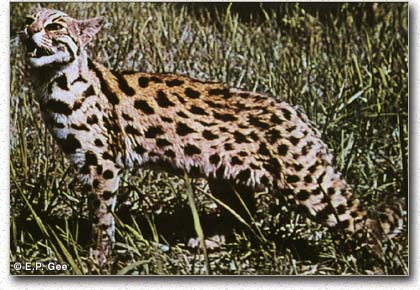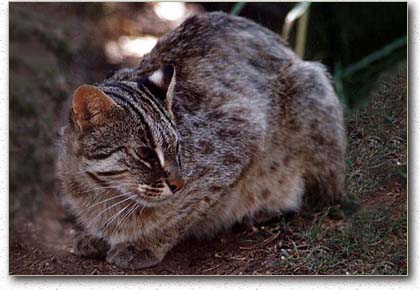|
About the Bengal Cat...
Bengal Cats are a breed of domestic cat
that mirrors the beauty of spotted wild-cats and yet makes a great house-pet. In
fact, the very first Bengals were created by out-crossing domestic cats with small
native spotted-cats, called Asian Leopard Cats.
Asian Leopard Cats
Asian Leopard Cats (or ALCs for short) are small, shy, nocturnal wild
cats weighing approximately 8-16 pounds at maturity. The males tend to be larger
than the females.
The first ALCs were discovered near the Bay of Bengal in India.
Therefore, these cats were given the scientific name of "Felis
Bengalensis". The name for the domestic breed was taken from the word
"Bengal".
The Asian Leopard Cat (or ALC for short) is indigenous to the jungles
and forests of India, China, and other parts of Asia. It is now known that
there are about 10 different sub-species, that vary somewhat in size, length of coat, and
coloring depending on the climate.
| Prionaliurus bengalensis bengalensis (also called Felis
bengalensis bengalensis) |
 |
Found in India, Indochina, and Malay peninsula. Tropical ALCs have shorter coats and are smaller than their northern relatives. |
| Prionaliurus bengalensis euptilurus |
 |
Found in Manchuria, Korea, and the Russian Far-East.
These
more northern ALCs tend to be larger. Some come from the Amur region of what was the
USSR and are nick-named "Amurs". |
To continue with the Bengal story......
Different species cannot be crossbred unless they are very
closely related, i.e., they probably both evolved from the same ancestral animal fairly
recently in evolutionary history. When a donkey is crossed with a horse, a mule
results. Mules cannot be bred; they are sterile. Therefore, to get more mules,
you must once again cross a donkey and a horse. Zoos have crossed Tigers and Lions,
but again, we did not get a new self-replicating breed.
The first Asian Leopard Cats were crossed with domestic cats as part of a research
effort to study cat diseases. After years of careful breeding, we now have sweet
affectionate house cats that resemble spotted jungle cats.
The first offspring produced by breeding an ALC to a
domestic cat is known as the "F1" generation. F1 is a genetics term that
means "first filial". Many of these attempted crosses do not produce live
young. When the kittens do survive, the F1 males are sterile. The F1 hybrid
females, on the other hand, can be fertile and can be bred to other domestic cats.
This is how the Bengal breed was established.
When an F1 female hybrid is crossed, the next
generation is called the F2. Once again, the F2 Bengal foundation males
are not fertile. The females are once again usually bred to domestic
males.
The same is true of the F3 foundation generation. A small percentage of the F3
males may occasionally produce some offspring.
These first three generations are registered by The International Cat Association
(TICA) as foundation cats and cannot be shown in TICA-sponsored cat shows. F1s and
F2s are often gorgeous, but should not be considered as pets for inexperienced households.
For example, they may be shy like their nocturnal forest-dwelling ancestors.
The fourth generation offspring are considered domestic Bengal cats. TICA
registers these as "SBTs". SBT pedigreed Bengals can be shown in
TICA-sponsored cat shows -- as well as shows sponsored by several other cat associations.
Fourth and following generation Bengals make great pets. By careful breeding,
TIBCS affiliated catteries maintain the "wild" look, but produce well-socialized
pets. Bengals are often selected as pets by previous dog owners, since they are
often more sociable and playful than some other breeds of cats. Visit our our
new babies.
Bengals are normal house-cat sized cats. However, since Bengals are
"modeled" on wild cats, they should be built somewhat differently than many
other types of house cats. They have "wild-looking" longish faces with large
eyes, white chins and cheeks, and small ears. They look muscular and have a
panther-like gait. Their shoulders are high and often visibly move when they
walk. Their hind legs are often longer than the front legs. They often carry
their tail low. As a result, they appear to stalk like a leopard in the jungle.
Their coats are short and as a result they usually do not shed as much as
longer haired cats. The coats are often called "pelts" because they are so much
like a fur-bearing animal's soft fur. And of course, they are spotted to
resemble their wild ancestors.
Did you know that more people are now selecting cats as pets than dogs? This
change appears to have occurred because most folks now work outside of the home
for long hours. Cats can be left alone with food and a litter box -- where as
dogs usually need to be walked.
Bengals often make good pets for dog-lovers as well as cat people. Bengals
are outgoing and enjoy games and interaction with their humans. Some of our
Bengals like to play fetch. A few will wear a harness and a leash. Several
like to play with water. They greet you at the door and "talk" to you. They
never stop entertaining their households.
The above information courtesy of Phyllis Koch.

Contact us for more info
| 